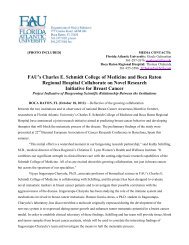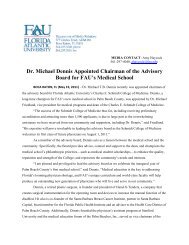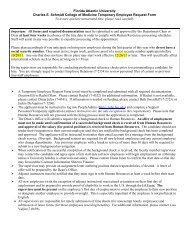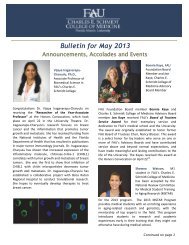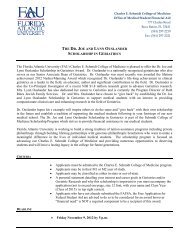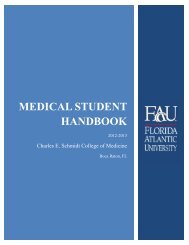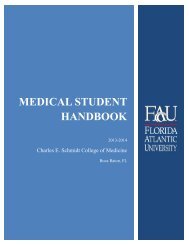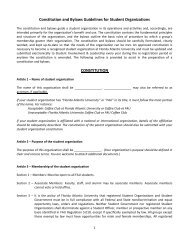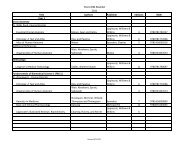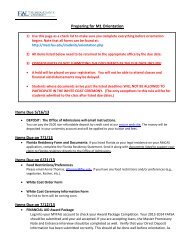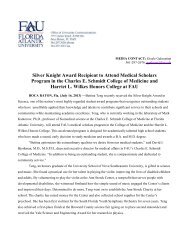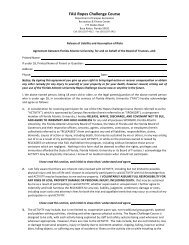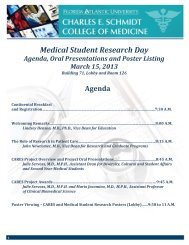Research Day Book 2013 - College of Medicine - Florida Atlantic ...
Research Day Book 2013 - College of Medicine - Florida Atlantic ...
Research Day Book 2013 - College of Medicine - Florida Atlantic ...
Create successful ePaper yourself
Turn your PDF publications into a flip-book with our unique Google optimized e-Paper software.
CONCLUSIONS: The Ca 2+ desensitizing molecule, (‐)‐epigallocatechin gallate (EGCg), can reverse the<br />
impaired relaxation and delayed Ca 2+ decay in RCM cardiac myocytes by restoring the my<strong>of</strong>ilament Ca 2+<br />
sensitivity. EGCg improves diastolic function in RCM mice without damaging the systolic function. The<br />
restored diastolic function was manifested by the correction <strong>of</strong> the prolonged IVRT in the RCM animals and<br />
the increased <strong>of</strong> the left ventricular end diastolic dimension in RCM mice following the treatment. The Ca 2+<br />
desensitizing properties <strong>of</strong> the green tea extract, EGCg, are beneficial for RCM and provide a therapeutic<br />
alternative for diastolic dysfunction due to increased my<strong>of</strong>ilament Ca 2+ sensitivity.<br />
REFERENCES:<br />
Du J, C Zhang, J Liu, C Sidky, XP Huang. Arch Biochem Biophys 456:143‐150, 2006.<br />
Du J, et al. Am J Physiol Heart Circ Physiol 294:H2604‐H2613, 2008.<br />
Robertson IM, MX Li, BD Sykes. J Biol Chem 284:23012‐23023, 2009.<br />
Tadano N, et al. Bri J Pharmacology 161:1034‐1043, 2010.<br />
Li Y, et al. J Mol Cell Cardiol 49:402‐411, 2010.<br />
Jean‐Charles P, Y Li, C Nan, XP Huang. J Geriatr Cardiol 8:168‐183, 2011.<br />
Chen G, et al. Biochem Res Internat doi:10.1155/2012/715197, 2012<br />
ABSTRACT TITLE: Annotation <strong>of</strong> neurodevelopmental regulators in dopaminergic and GABAergic<br />
neurons for links to ischemia‐hypoxia response<br />
AUTHORS: Kim McKain, Maryanne Joseph, Rainald Schmidt‐Kastner<br />
DEPARTMENT: Integrated Medical Science<br />
BACKGROUND: A leading concept for the pathogenesis <strong>of</strong> schizophrenia (SCZ) is based on gene –<br />
environment interactions during neurodevelopment. In previous in silico work, genes associated with the<br />
risk <strong>of</strong> SCZ were examined for links to ischemia‐hypoxia responses and vascular factors, and a significant<br />
overlap was demonstrated (1, 2). Our analysis has stimulated clinical studies <strong>of</strong> gene x environment<br />
interactions in SCZ (3). In preparation for translational research, we are now developing strategies to create<br />
gene databases related to a) known pathophysiological mechanisms for SCZ, b) regulation <strong>of</strong><br />
neurodevelopment, and c) ischemia‐hypoxia responses in the brain. Dysfunction <strong>of</strong> the dopaminergic (DA)<br />
system in SCZ has been confirmed by recent PET studies <strong>of</strong> dopamine receptors, and abnormalities <strong>of</strong><br />
GABAergic cortical interneurons have been described in post‐mortem tissue.<br />
OBJECTIVES: The aim <strong>of</strong> this study is to define possible interactions between neurodevelopmental<br />
mechanisms for DA and GABAergic neurons and ischemia‐hypoxia responses. Using literature‐mining, we<br />
generated databases for genes/proteins broadly related to the development <strong>of</strong> the DA midbrain neurons or<br />
GABAergic telencephalic interneurons, and then looked for an overlap with our own databases for<br />
ischemia‐hypoxia responses.<br />
METHODS: Lists <strong>of</strong> genes related to regulation <strong>of</strong> DA and GABAergic neurogenesis were generated via<br />
literature mining (PubMed, Web <strong>of</strong> Knowledge) and by compilation <strong>of</strong> gene expression pr<strong>of</strong>iling studies.<br />
Genes expressed during development <strong>of</strong> DA and GABAergic were annotated using the ischemia‐hypoxia



